MARIANI’S
JULY 31, 2005
NEWSLETTER
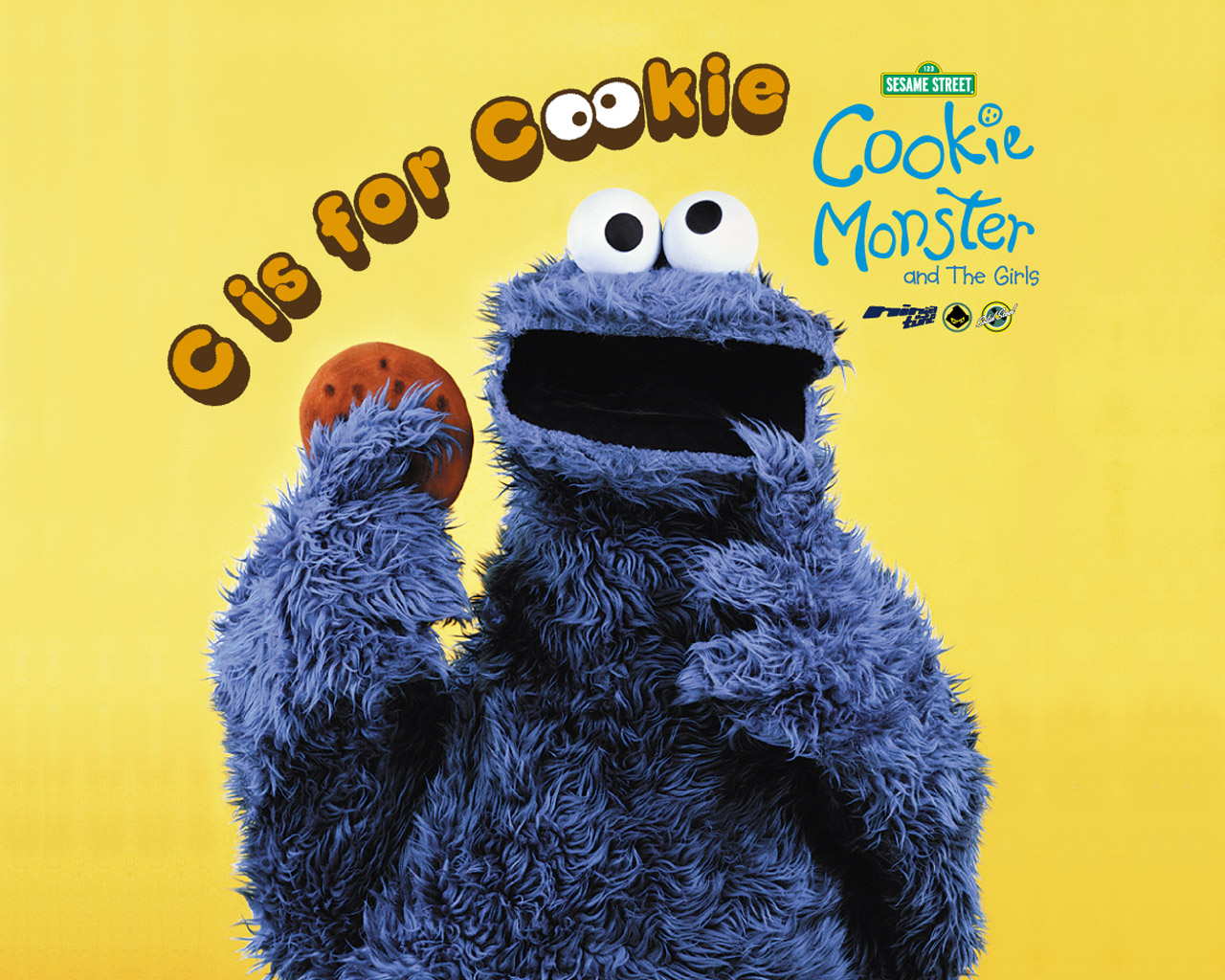
UPDATE:
To
go to my web site, in which I will update food
&
travel information and help link readers to other first-rate travel
& food sites, click on: home page
ACCESS TO
ARCHIVE: Readers may now access
an
Archive of all past newsletters--each annotated--dating back to July,
2003, by simply clicking on www.johnmariani.com/archive
.
NEW
FEATURE! You may now subscribe anyone you wish
to this newsletter by
clicking here.
EDITOR'S
NOTE: VACATION TIME--There will be no
issue of Mariani's
Virtial Gourmet Newsletter
next week because Mariani will be on vacation. Publication will
resume with the August 14 edition.
In
This Issue
NO COOKING
NECESSARY: Ceviche by John Mariani
NEW YORK
CORNER: Brasserie Les Halles Downtown Has Sunday Syndrome by John
Mariani
NOTES FROM
THE WINE CELLAR: Stellar Valpolicella by Mort Hochstein
~~~~~~~~~~~~~~~~~~~~~~~~~~~~~~~~~~
NO COOKING NECESSARY:
Ceviche
by John Mariani
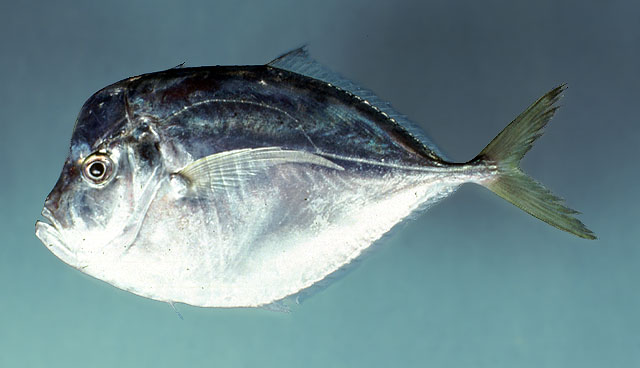 I
strongly suspect that the first thing the
first man to eat the first morsel of cooked food said, was “Hey, guys,
c’mere
and taste this!”
I
strongly suspect that the first thing the
first man to eat the first morsel of cooked food said, was “Hey, guys,
c’mere
and taste this!”Up until that moment--which was some time around 500,000 years ago and might have occurred after a forest fire accidentally blackened a mastodon or someone accidentally left some newly caught fish on a stone heated by the sun--everything man ate was raw. Ever since then the cooked has won out over the raw in every civilization on earth.
But at the moment--who knows how long culinary fashions last?--the hottest food around seems to be room-temperature ceviche, a Central and South American method of “cooking” fish and other foods by marinating them in an acidic bath like vinegar or citric fruit juice, which breaks down the surface proteins, making them tender and flavorful. Some trendy restaurants in New York have entire menus devoted to the concept, while there is hardly a deluxe dining room in San Francisco, Houston, even Las Vegas that isn’t doing some twist on the idea. These days raw food seems associated with slim people for whom the ingestion of cooked meat is totally un-cool, and you’re far more likely to read about people with names like Leonardo, Cher, Brittany, and Claudia dining at restaurants with names like Moomba, Nobu, and !Pasion! featuring ceviche than at places named Al’s and Otto’s serving roast beef and bratwurst.
No one knows how long ceviches have been made in Central and South America, where lime or lemon juice, olive oil and spices are used to cure the fish, although the idea might have been brought by the Spanish, who themselves learned the method from the Arabs sometime before the 14th century. You’ll find marinated raw fish dishes throughout the Mediterranean (Venetians call it pesce in saor--”fish in sour sauce”), and Spain’s escabeche actually refers to lightly fried fish marinated in acidified seasonings. Filipinos have been using such marinades for a thousand years under the name kinilaw, and
So there’s nothing new about ceviche except its current faddishness. One of the first to adapt the idea in the U.S. was the late Gilbert LeCoze (below),
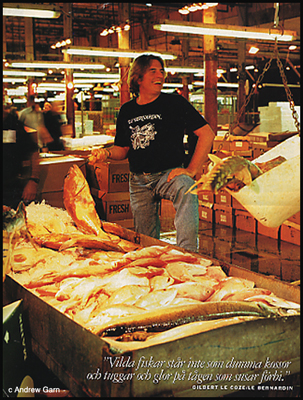 chef-owner of
what is arguably the finest seafood restaurant in the world--
chef-owner of
what is arguably the finest seafood restaurant in the world--Next into the pond was Nobu Matsuhisa (below) at his namesake Matsuhisa
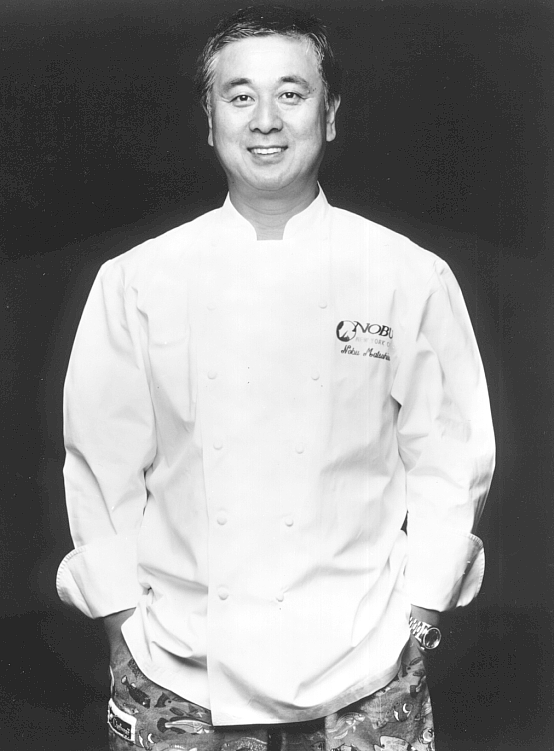 restaurant in Beverly
Hills, then at the myriad Nobu restaurants around the world. Matsuhisa
really revolutionized the genre by
adding spices, chile pepper condiments, and other ingredients to sushi
he calls tiradito--ideas he picked up when working for
several
years in Peru,
which has a substantial Japanese population. Thus,
at any of the Nobus, you may sample his “New Style sashimi” of
Atlantic
salmon spiced with garlic, ginger, sesame seeds, citron, and olive oil. The fish’s own lush fat mingles with the
nuances of the aromatics of the garlic and zest of the ginger, the
tactile
texture of the toasty sesame, the bite of citron and the slick green
benediction of the olive oil. He also
serves an exotic ceviche of monkfish
liver in a citrus miso marinade.
restaurant in Beverly
Hills, then at the myriad Nobu restaurants around the world. Matsuhisa
really revolutionized the genre by
adding spices, chile pepper condiments, and other ingredients to sushi
he calls tiradito--ideas he picked up when working for
several
years in Peru,
which has a substantial Japanese population. Thus,
at any of the Nobus, you may sample his “New Style sashimi” of
Atlantic
salmon spiced with garlic, ginger, sesame seeds, citron, and olive oil. The fish’s own lush fat mingles with the
nuances of the aromatics of the garlic and zest of the ginger, the
tactile
texture of the toasty sesame, the bite of citron and the slick green
benediction of the olive oil. He also
serves an exotic ceviche of monkfish
liver in a citrus miso marinade.A NOTE ABOUT RAW FISH
If you are squeamish about eating any raw foods, there is some reason to be so. The Center for Disease Control, along with state and federal marine organizations in the business of promoting shellfish sales warn that eating raw shellfish can be problematic and recommend cooking it. Ceviches are not really “cooked,” but only seasoned and tenderized. The marinade does have a preservative effect, too. But raw fish, like many foods, can cause allergic reactions in some people, which may be mild or very serious, including anaphylactic shock, while raw shellfish can also carry deadly diseases like hepatitis and cholera. They may also carry worms and parasites. People with liver disease, diabetes or cancer should be especially careful.
Matsuhisa’s success spurred other, non-Japanese chefs to go further with such ideas. At Ortanique in Coral Gables, Florida, chef Cindy Hudson does a trio of Jamaican-inspired ceviches--Caicos island conch infused with a citrus-mango vinaigrette and served with potato fritters; red snapper with red and yellow peppers, smoked ancho chilies, cilantro, avocado salsa and tostone rounds; and button mushroom ceviche with fresh thyme, roasted garlic, infused with olive oil, red onion, and Scotch Bonnet peppers, served with herbed toasted bread.
Dominique Macquet, a Frenchman born in Mauritius and now at Dominique’s in New Orleans, does ahi tuna combined with bell peppers, red onion, and cucumbers with a vinaigrette of soy, lime juice, and grapeseed oil, all set atop paper-thin, crispy pineapple slices done in the oven. And in Chicago the restlessly creative Charlie Trotter of Charlie Trotter’s makes a dish he rightly calls “decadent”--julienned daikon radish set with raw sea urchins tossed in lemon juice and spoonfuls of caviar dressed with vodka crème fraîche and parsley juice.
Ceviche, also spelled "seviche," has achieved its highest prominence in restaurants that proudly proclaim themselves Nuevo Latino. an umbrella term for the foods of Central and South America as well as the Caribbean. One of the pioneers in the movement was Cuban-American chef Doug Rodriguez, first at Yuca in Coral Gables, then at Patria in New York, now closed.
SushiSamba in NYC and other cities has taken the Latino idea to a delectable extreme. The number of Peruvian-style ceviches is enormous, always changing and, again, drawing on flavors and ingredients from Cuba to Panama. At SS you’ll find giant clam with jalapeño mayonnaise and lobster with mango and lemon.
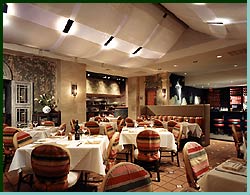 One
of the finest--make that most
refined--practitioners of ceviche magic is Argentine-born Guillermo
Pernot of
the appropriately named !Pasion!
(left) in Philadelphia. Pernot
shows
tremendous
subtlety, choosing to bring out the flavor of the basic fish, using the
seasonings and marinade as notes not intended to overpower the fresh
taste of
the sea. His ceviches are bracing appetizers, although you may want to
gorge on
them and skip the main courses. (Don’t: they’re sensationally good!) His platter of whole white anchovies with
tomatoes, cucumbers and a trio of olives salad. is a brilliant example
of his
finest work.
One
of the finest--make that most
refined--practitioners of ceviche magic is Argentine-born Guillermo
Pernot of
the appropriately named !Pasion!
(left) in Philadelphia. Pernot
shows
tremendous
subtlety, choosing to bring out the flavor of the basic fish, using the
seasonings and marinade as notes not intended to overpower the fresh
taste of
the sea. His ceviches are bracing appetizers, although you may want to
gorge on
them and skip the main courses. (Don’t: they’re sensationally good!) His platter of whole white anchovies with
tomatoes, cucumbers and a trio of olives salad. is a brilliant example
of his
finest work.The idea for marinated seafood is now spreading into other ethnic foods, as well. One of those I find most appealing and very influential is the ceviche Italian-style developed by Chef David Pasternak at Esca, a NYC Theater District restaurant run by Mario Batali and Joe Bastianich. Here the menu is about 99 percent seafood, and a major category on it is named crudi--“raw” in Italian. Many of the Mediterranean species, like branzino, orata, and pezzogna are sliced into thin sheets or sushi-like morsels and dressed them with any of a variety of extra virgin olive oils and a few crystals of any of 20 sea salts. The result is an epiphany of flavors and textures: the luxury of the fish itself is ennobled by the olive oil, which may be sweet, or nutty, or green, and the pungent tactile sensation of the sea salt, which may be white or golden or gray.
The simplicity of the ceviche idea married to the creativity of modern American chefs has taken the genre to heights no one would have thought possible even five years ago. That something so naked, so crude, so raw and so slippery could become chic is to admit to certain notions of sensuality. Then again, it might be its Zen-like purity. Whatever it is, I suspect ceviches are going to be around long after their current faddishness fades.
RESTAURANTS:
Le Bernardin--155 West 51st Street, NYC; 212-489-1515.
NEW
YORK CORNER
by John
Mariani
Brasserie Les Halles DOWNTOWN
15 John Street
212-285-8585
www.leshalles.net
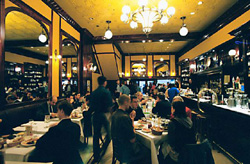 "Sunday in New York" has a
lovely ring to it, but when visiting restaurants, you might want to tag
on "caveat emptor." Most restaurants close on Sunday for the same
reason that God rested. A restaurant's strengths and even its momentum
run low after six days of work, with Saturday often being the toughest
night of the week. Restaurateurs and chefs, therefore, usually
send in a grumpy "B" team to work the front and back of the house on
Sunday, a slow day when customers are likely to be the least
demanding. For this reason, Sunday brunch is always bound to be the
worst
meal of the week.
"Sunday in New York" has a
lovely ring to it, but when visiting restaurants, you might want to tag
on "caveat emptor." Most restaurants close on Sunday for the same
reason that God rested. A restaurant's strengths and even its momentum
run low after six days of work, with Saturday often being the toughest
night of the week. Restaurateurs and chefs, therefore, usually
send in a grumpy "B" team to work the front and back of the house on
Sunday, a slow day when customers are likely to be the least
demanding. For this reason, Sunday brunch is always bound to be the
worst
meal of the week.I say all this as after a truly disappointing experience at Brasserie Les Halles, the four-year-old downtown branch of the Park Avenue original (they also run units in Miami and DC), where author-chef Anthony Bourdain made his reputation as New York's bad bay cook. Bourdain has said he doesn't actually cook much at Les Halles any more, and I don't know that he's ever cooked at the downtown branch. Whoever is, on Sundays, does little justice to a restaurant I've always enjoyed and found remarkably consistent over the years. But when the kitchen's heart and mind is not into their work, nothing will work. Owner Philippe Lajaunie must really take a look at what goes when he is not around (which goes for the other branches, too).. As Bourdain wrote in his book Kitchen Confidential, "Most chefs are off on Sundays, so supervision is at a minimum. Consider that before ordering seafood frittata."
Les Halles Downtown was one of the first restaurants to open after 9/11, and it's been embraced by the neighborhood, both during the day when it bustles with Wall Streeters and at night when the locals come in. The menu runs from noon till late at night, and prices are quite easy to take, with appetizers $5.50-$13.50 and main courses $14.50-$28 (with a côte du boeuf for two at $58).
Take this review, then, with a grain of sea salt, more as an essay on the "Sunday Syndrome" than on the prospects of getting a good meal at Les Halles at other times. We arrived at the restaurant at about 7 PM on a warm summer's night and found the place nearly empty, though a crowd was building by eight. The restaurant is located in the Wall Street area, which is pretty grim and deserted on Sunday, its huge towering buildings closing off the light. The decor is quaint, neither bright nor too dark, but it needs a crowd to make it vivacious. But the bustle of a good, well-run brasserie can always bring bonhomie to any evening.
The Sunday wait staff could hardly have exhibited more disinterest. The waitress, who seemed not to know much about the menu or the wines, came and went. The busboys did about the same. one of them dropping silverware on the floor and replacing the same back on the table. The bartender was clueless as to how to make either a daiquiri or a negroni, even after being told precisely how to do so. (He decided to add his own touches, which were awful.)
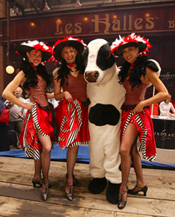
The wine list is full of regional wines you may or may never see again when they run out; prices are quite reasonable, however. The menu is an enchantment for anyone longing for those beloved brasserie/bistro favorites that never go out of style, from platters of shellfish and pâtés to coq au vin and steak frites.
We began with a tartiflete, a creamy, extremely rich gratin of reblochon cheese, bacon, and fingerling potatoes. Pétatou de chèvre was a warm potato and black olive salad with a goat's cheese gratinée that was satisfying but missed being wonderful by a long shot. Two preparations of mussels--Portuguese, with garlic, cilantro, chorizo, and tomato, and Grecque, with olive oil, lemon juice, and vermouth--were abundant. You might want to note that Bourdain has warned, "I don't eat mussels in restaurants unless I know the chef personally, or have seen, with my own eyes, how they store and hold their mussels for service."
Then came the main courses--one mediocrity after another. A flaccid-skinned roast chicken was dry and drab; roast duck à l'orange was pitiful--dried out, not in the least crisp, with a sauce that reminded me why this dish went out with bad continental cuisine (although when well prepared it is still a worthwhile classic). A NY sirloin with red wine-butter sauce was a tasteless piece of beef inexpertly cooked, with a gray, watery gravy. The saving grace of mid-meal were the superlative frites, which practice has made close to perfect here.
A limp, poorly caramelized tarte Tatin was poor homage to the two French sisters reputed to have created the dish, and profiteroles were chewy, tasting as if made hours before and left to lie around to absorb humidity.
This was not the kind of meal I'd learned to love at Les Halles and still yearn for. I'll return to keep on check on things, but, never on Sunday.
NOTES
FROM THE WINE CELLAR
Stellar Valpolicella
by Mort Hochstein
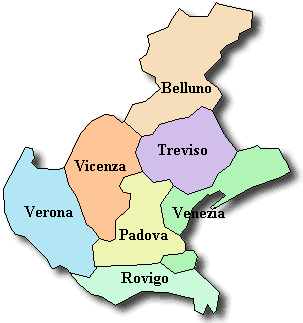
Italy's
Veneto Region
It
would be glib to call Sandro
Boscaini (below) the "Robert
Mondavi
of the 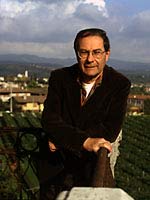 the
winery leading the battle to restore valpolicella to the position
it once
held in the marketplace--an almost
Sisyphean task at a
time when the wines of
the
winery leading the battle to restore valpolicella to the position
it once
held in the marketplace--an almost
Sisyphean task at a
time when the wines of
Unlike
many of his Italian compatriots,
Masi has resisted the lemming-like trend toward adopting popular
international
varieties—cabernet, chardonnay, and merlot—using instead traditional
Veneto grapes
to satisfy unadventurous consumers. One of his innovations has been
with amarone, the premier wine of the region, made by drying
grape
clusters for several months in old
farmhouses with windows that allow a free flow of air.
The dried grapes lose
more than 40% of their weight and yield a
full-bodied, faintly sweet wine showing
traces of botrytis, the
same "noble rot" that produces greatness in Sauternes and the great
German dessert wines. Amarone is, however,
strictly an acquired
taste, like port or brandy.
Boscaini created a
wine that mates the
drinkability of valpolicella with the structure of amarone. It is called Campofiorin, and it
is made through a second fermentation of
valpolicella on the pomace of the dried grapes used for making amarone. It is an extraordinary wine, often called
a “super
Venetian.”
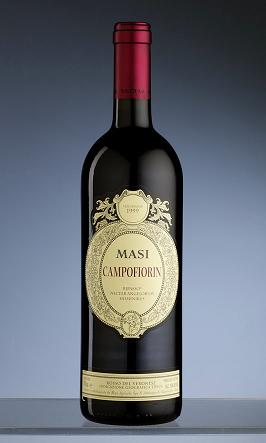 Campofiorin spearheaded a new group
of wines from the
Campofiorin spearheaded a new group
of wines from the
Boscaini
is an eighth generation winemaker
in a family whose viticultural roots go back
to the late 1700’s, when his ancestors purchased
vineyard territory
known as the Vaio del Masi ("valley of the houses") in the hills near
Verona. Land holdings multiplied over
the centuries to encompass more than
400 acres under cultivation in Valpolicella, Bardolino and Soave, with
additional holdings in
The
winery’s Bonacosta Classico
is its
basic valpolicella, a
blend of 70% corvina, 25% rondinella and 5% molinara, called "Classico"
because
all grapes come from the original appellation. It’s an easy-to-drink
wine,
moderately priced at $11,
full-bodied, with earthy, black cherry flavors and aroma and a hint of
licorice.
Masi’s
basic Campofiorin (above), is,
in essence, a "baby Amarone," its
flavors
and structure heightened by the double fermentation of the ripasso process. Priced at $14.99,
it is
made from the same grapes as the basic valpolicella but is bigger and
more
charming in every way.
Further
up the ladder is Brolo de
Campofiorin, oak aged and made from 80% corvina and 20%
rondinella.
Very dark,
it sends up a red and black cherry bouquet with overtones of coffee
and
chocolate and a long follow-through. $28.
Amarone, however, is what
makes Masi
great. Its Costassera Amarone Della
Valpolicella, at $39, is a classic blend
made from
the best hillside-grown grapes, dried in wooden boxes or
on bamboo racks for up to two days in a
controlled climate, then
further dried until mid-January in
farmhouses with
large openings to allow a free flow of air. Before
pressing, the grapes lose more than a third of
their weight and
develop concentrated flavor and sugar after the onset of botrytis. It
takes
three years of nurturing before the amarone reaches the market as a
somewhat
dry potion, with dark fruit, earthy flavors and great length.
Top of their line is
the Campolongo
di
Torbe Amarone, made from grapes grown at the top of a mountain
above
the fog
line. Somewhat sweeter than the Costassera, it is velvety and loaded
with
aromas of cherry, black cherry, raisin and earth tones. This is a wine
to be
enjoyed at great length, slowly and contemplatively and one that will
surely last
another 40 years. It costs in the range of a fine
The
Masi wines, with their emphasis on
tradition in the winery and in the vineyards, represent true,
traditional Italian
wine
culture, and the success of this family-operated winery is reassuring
in an era when huge conglomerates seem
to be
making the same wines throughout the world.
FOOD
WRITING 101: Molly Bloom's
soliloquy is not a good
model for
food writing 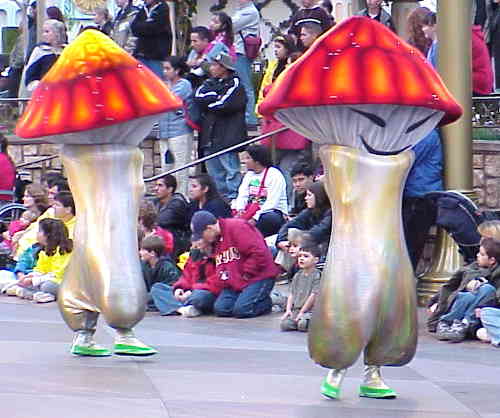
"Pastry chef Frank Urso, who
previously worked at Lacroix, presents
some unexpected desserts, including a sweet-tart wedge of slow-roasted
apple slices that's like a crustless apple tart, and a whimsical trio
of s'mores capped by lightly browned, half-melted marshmallows that
slump like the cartoon mushroom caps of Disney's Fantasia over undersides of soft
graham cracker, fudgy chocolate, and a scoop of peanut butter ice
cream."--Maria Gallagher in Philadelphia
Magazine.
Well, Who Wouldn't?
Upon being told that the Burger King drive-thru
in DuBois, PA, was out of French fries on New Year's Day, Gregg Luttman
made on obscene gesture at the clerk, walked into the restaurant and
cursed out the staff, then put his truck into reverse, nearly hitting
an employee.
QUICK BYTES
* Beginning Aug. 6,
* The entire month of August,
* On Aug. 6 & 27, NYC’s Suenos will hold cooking classes, the first on “
~~~~~~~~~~~~~~~~~~~~~~~~~~~~~~~~~~~~~~~~~~~~~~~~~~~~~~~~~~~~~~~~~~~~~~~~~
MARIANI'S VIRTUAL GOURMET NEWSLETTER is published weekly. Editor/Publisher:
John Mariani. Contributing Writers: Robert Mariani, Naomi
Kooker, Kirsten Skogerson, Edward Brivio, Mort
Hochstein, Lucy Gordan, Suzanne Wright. Contributing
Photographers: Galina Stepanoff-Dargery, Bobby Pirillo. Technical
Advisor: Gerry McLoughlin.
Any of John Mariani's books below
may be ordered from amazon.com by clicking on the cover image.
 |
 |
 |
 |
 |
 |
copyright John Mariani 2005